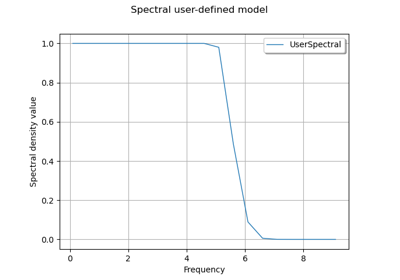SquareComplexMatrix¶
- class SquareComplexMatrix(*args)¶
Complex square matrix.
- Parameters:
- sizeint,
, optional
Matrix size. Default is 1.
- valuessequence of complex with size
, optional
Values. OpenTURNS uses column-major ordering (like Fortran) for reshaping the flat list of values. Default creates a zero matrix.
- sizeint,
Examples
Create a matrix
>>> import openturns as ot >>> M = ot.SquareComplexMatrix(2, range(2 * 2)) >>> print(M) [[ (0,0) (2,0) ] [ (1,0) (3,0) ]]
Get or set terms
>>> print(M[0, 0]) 0j >>> M[0, 0] = 1.0 >>> print(M[0, 0]) (1+0j) >>> print(M[:, 0]) [[ (1,0) ] [ (1,0) ]]
Create an openturns matrix from a square numpy 2d-array (or matrix, or 2d-list)…
>>> import numpy as np >>> np_2d_array = np.array([[1.0, 2.0], [3.0, 4.0]]) >>> ot_matrix = ot.SquareComplexMatrix(np_2d_array)
and back
>>> np_matrix = np.matrix(ot_matrix)
Methods
clean(threshold)Clean the matrix according to a specific threshold.
Accessor to the conjugate complex matrix.
Accessor to the transposed conjugate complex matrix.
Accessor to the object's name.
Accessor to the dimension (the number of rows).
getId()Accessor to the object's id.
Accessor to the underlying implementation.
getName()Accessor to the object's name.
Accessor to the number of columns.
Accessor to the number of rows.
imag()Accessor to the imaginary part.
isEmpty()Test whether the matrix is empty or not.
real()Accessor to the real part.
setName(name)Accessor to the object's name.
solveLinearSystem(*args)Solve a system of linear equations.
solveLinearSystemInPlace(*args)Solve a system of linear equations.
Accessor to the transposed complex matrix.
- __init__(*args)¶
- clean(threshold)¶
Clean the matrix according to a specific threshold.
- Parameters:
- thresholdpositive float
Numerical sample which is the collection of points stored by the history strategy.
- conjugate()¶
Accessor to the conjugate complex matrix.
- Returns:
- N
ComplexMatrix The conjugate matrix
of size
associated with the given complex matrix
such as
.
- N
- conjugateTranspose()¶
Accessor to the transposed conjugate complex matrix.
- Returns:
- N
ComplexMatrix The transposed conjugate matrix
of size
associated with the given complex matrix
such as
.
- N
- getClassName()¶
Accessor to the object’s name.
- Returns:
- class_namestr
The object class name (object.__class__.__name__).
- getDimension()¶
Accessor to the dimension (the number of rows).
- Returns:
- dimensionint
- getId()¶
Accessor to the object’s id.
- Returns:
- idint
Internal unique identifier.
- getImplementation()¶
Accessor to the underlying implementation.
- Returns:
- implImplementation
A copy of the underlying implementation object.
- getName()¶
Accessor to the object’s name.
- Returns:
- namestr
The name of the object.
- getNbColumns()¶
Accessor to the number of columns.
- Returns:
- ncint
The number of columns of
.
- getNbRows()¶
Accessor to the number of rows.
- Returns:
- nrint
The number of rows of
.
- isEmpty()¶
Test whether the matrix is empty or not.
- Returns:
- isEmptybool
Flag telling whether the dimensions of the matrix is zero.
- setName(name)¶
Accessor to the object’s name.
- Parameters:
- namestr
The name of the object.
- solveLinearSystem(*args)¶
Solve a system of linear equations.
- Parameters:
- B
ComplexMatrix Second member
- B
- Returns:
- X
ComplexMatrix The solution to A * X = B.
- X
- solveLinearSystemInPlace(*args)¶
Solve a system of linear equations.
- Parameters:
- B
ComplexMatrix Second member
- B
- Returns:
- X
ComplexMatrix The solution to A * X = B.
- X
Notes
Unlike
solveLinearSystem()this method does not copy the matrix A and alters it in-place during the resolution, so the content of A may change.
- transpose()¶
Accessor to the transposed complex matrix.
- Returns:
- N
ComplexMatrix The transposed matrix
of size
associated with the given complex matrix
such as
.
- N
 OpenTURNS
OpenTURNS
